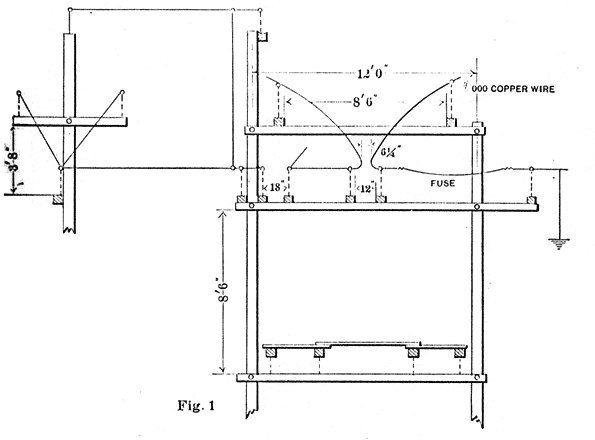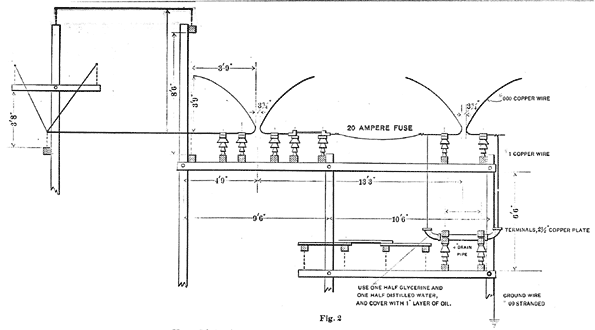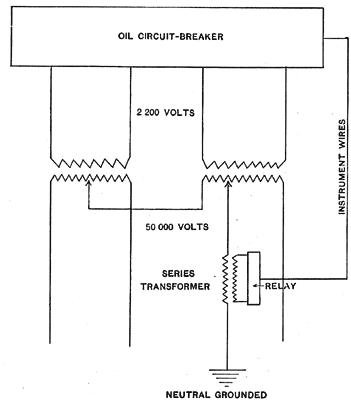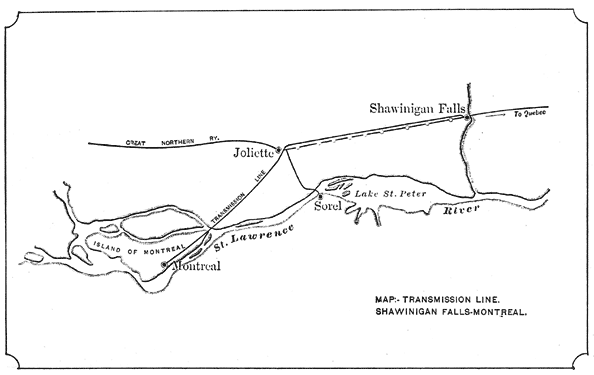[Trade Journal]
Publication: American Institute Of Electrical Engineers
New York, NY, United States
p. 985-993, col. 1
SOME EXPERI ENCES WITH LIGHTNING PROTECTIVE APPARATUS.
BY JULIAN C. SMITH.
This paper will deal with some experiences with lightning protective apparatus which the operating department of the Shawinigan Water & Power Company has had during the years 1903, 1904, and 1905.
The generating station at Shawinigan Falls has three generators each of 3,750-kw. capacity, 2,200-volt, 30-cycle, two-,phase, and one generator of 6,600-kw. capacity, 2,200-volt, 30-cycle, two-phase. Each of these generators is direct-connected to a water-wheel operating under a head of 130 ft.
Referring now only to the long-distance lines, it is sufficient to note that the energy is delivered through a double set of bus-bars to the low-tension side of the step-up transformers. These transformers are T-connected for transforming from two-phase to three-phase. The ratio of voltage transformation is 2,200:50,000. The neutral point of these transformer banks is grounded, giving about 29,000 volts between each wire and earth.
In 1903, only the No. 1 Montreal line was operating. This line connected the generating station at Shawinigan Palls, P. Q., with the Montreal terminal station, situated just outside the city of Montreal. The distance from the generating station to the terminal station is 85 miles. The transmission line consists of three 7-strand aluminum cables, each of 185,000 cir. mils cross-sectional area, spaced 60 in. apart and arranged in the form of an equilateral triangle with the apex upward. These cables are supported on 35-ft. poles, with cross-arms 6 ft. long fastened with through bolts. The top of every pole is bored to receive a pin. All pins are 18 in. long, and were boiled in stearine.
The voltage at Shawinigan is normally about 50,000; at the Montreal terminal station it is 44,000.
In the spring of 1904, a sub-station was built in Joliette, distant about 45 miles from the generating station, and from this sub-station a branch line was built to the city of Sorel. This line is about 20 miles long and is operated at 12,500 volts. The only special point of interest is -a submarine cable about 5 000 ft. long by means of which the line crosses the St. Lawrence River.
In the Montreal terminal station, the voltage is reduced to 2,400 and supplied to a set of 30-cycle bus-bars. From these bus-bars the frequency-changers are operated. Each frequency-changer consists of a 30-cycle synchronous Motor connected to a 60-cycle generator. There are at present installed in this station five of these motor-generators each of 1,000-kw. capacity and one of 5,000-kw. capacity. In addition to these machines there are two synchronous converters, each of 1,000-kw. capacity, operating street railway circuits. It is interesting to note that the whole load of the long-distance line consists of synchronous apparatus, and that by properly regulating the fields of this apparatus the power-factor can be kept at unity.
In the fall of 1904 the No. 2 Montreal line was completed. The No. 2 line is parallel to the No. 1 line for nearly the entire distance, and in most places is not more than 100 ft. distant. The second line is similar to the first except for the size of the conductor and for the fact that a ground-wire is strung along the line at the neutral point of the triangle. This ground-wire is connected to the earth at each pole by a wire running down the pole.
When the No. 1 line was put into service the lightning apparatus installed was as follows: at each end of the line was a bank of Westinghouse lightning-arresters of the low-equivalent type and a bank of static-interrupters. The number of gaps in these arresters was decided upon only after a series of tests had been made to determine the lowest practicable break-down voltage. These arresters were set to discharge at about 65,000 volts. In 1904, a bank of General Electric arresters was placed on the 50,000-volt line in the Joliette sub-station. This bank was also adjusted to discharge at about 65,000 volts.
In 1904 three banks of horn-arresters were put on the No. 1 Montreal line. These arresters consist of bent copper rods. The horns were spaced 6.25 in. apart at the gap, this distance corresponding to a break-down voltage of 90 000. See Fig. 1. In 1905, when the No. 2 line was equipped with lightning-arresters, three banks of low-equivalent arresters were put in, one at each end and one at Joliette. In addition to these arresters three banks of the 1905 type of horn-arresters were put in. Some changes were made in the setting of these arresters as will be noted farther on.
 |
| Fig. 1 — Horn Lightning-Arrester, Joliette. |
The Montreal lines run in a general northeasterly southwesterly direction, parallel to the St. Lawrence river and about 20 miles distant from it. The elevation of the power-house is about 200 ft. above sea-level, that of the sub-station being nearly the same. Some 10 miles farther north and parallel to the transmission lines, the Laurentian mountains bound the north side of the St. Lawrence Valley. In general, the country over which the lines pass is a fiat farmland, but near the power-station the country is very rough.
 |
| Fig. 2 — Horn Lightning-Arrester and Resistance. Type 1905. |
The prevailing winds are westerly, and the general course of the electrical storms is parallel to the lines. The storm period extends from March to October. Nearly all the storms occur during, the latter part of June, and in July, August, and early in September. The storms are most severe during July and August. In the territory covered by the lines of the Shawinigan company there occurs during each year about fifteen thunder storms. As these storms move along in an easterly direction and sometimes take days to cover the 100 miles, we have found that from June 25 to September 10, a storm is reported nearly every day from some part of the line. In general, however, there are not more than four or five severe storms during each year, and these storms are most severe in well defined localities. The discussion of our experiences with lightning will be simplified if these experiences during 1903, 1904, and 1905 are considered separately, year by year.
As stated above, the only line in operation in 1903 was the No. 1 Montreal line. That line was protected by low-equivalent arresters at each end. During the summer of 1903, several disturbances occurred, winch may be summarized as follows:
1. Poles splintered by heavy discharges.
2. In a few instances, insulators broken.
3. Flashes across the static-interrupter terminals.
4. Arcs on the transformer terminals.
5. Arcs inside the transformer cases at the top between adjacent leads.
6. Damage to apparatus caused by 3, 4, and 5.
7. Interruption to service, due usually to excessive voltage drop, causing synchronous apparatus to fall out of step.
 |
| Fig. 3 — Transformer Connections. Note: Neutral Point Grounded Through A Series Transformer and Relay. Current in Ground-Wire Trips Oil Circuit-Breakers. |
1. On several occasions poles were splintered. In most cases-two or three poles were torn to pieces; the adjacent poles on both sides were less damaged, the damage decreasing as the distance increased from the point of disturbance. One of the worst cases recorded by us shows that 5 poles were torn to pieces while 10 poles on each side were somewhat splintered. This disturbance extended over a distance represented by 25 poles, or about 2,500 feet. Tins case, however, is exceptional, usually not more than one pole is badly damaged, and a few of the nearby poles slightly splintered.
2. In only one or two instances were insulators broken; in each instance it was the top insulator. In these cases, the breakage seemed due to the flashing over and consequent heating, as the insulator was not in any case punctured. In no case was an insulator so badly damaged as to need immediate replacing.
3. At the same time that the poles were splintered on the line, there would be evidences of excessive potential in the stations. The most frequent occurrence was an arcing over on the terminals of the static-interrupters. In some cases this flash would reach across to an adjacent static-interrupter and establish a short circuit between the lines. In most cases, however, it was simply a flashing from the ends of the terminal to the case, or between the incoming and outgoing wires of a single static-interrupter, thereby short circuiting the reactance coil.
4. The arcs on the transformer terminals were more rare, only occurring when the static-interrupters were put out of service by the flashing over mentioned above.
In view of the above disturbances and damage it was decided to put in a type of horn lightning-arrester affording a low resistance path to ground, to depend on a fuse for the interruption of the short circuit which would occur if the horns did not break the arc, and to set these horns so that only the heavier discharges would break them down. The horns were consequently adjusted to discharge at about 90,000 volts.
 |
At the end of 1903, it was determined that the arresters installed were sufficient to meet the conditions caused by ordinary storms. They protected the line from abnormal rises of potential due to switching or short circuits; but in those cases when the lightning-stroke damaged poles on the line the rise of potential was so high and took place so rapidly that the arresters could not carry enough current to keep the potential of the line within safe limits. The horns installed were especially designed to meet only the conditions which were not met by the standard arresters.
In 1904 there were more than the usual number of storms. On the following dates the horns discharged:
Date. Shawinigan. Joliette. Montreal
July 11 ..3 horns 1 horn None
Aug. 5 ...2 " 3 horns "
Sept. 20 .2 " 2 " "
One or two storms did not cause any disturbance.
The storm of July 11 was central near the power-station, and one pole about five miles distant was splintered. The Joliette horns discharged about an hour before the discharges took place at Shawinigan.
On August 5, the storm was central at Joliette. Both the horn arresters and the standard arresters discharged violently the horns at Shawinigan discharging at the same time. There was evidently a rise of potential in the Joliette station, as one of the glass windows through which the wire enters the building was cracked, due to the flashing over which must have occurred, At the same time that this disturbance occurred in the station, some 25 poles about five miles away were splintered, a few of them very badly. No disturbance other than the discharge of the arresters occurred in the other stations. The service was not interrupted, a rather severe blow being felt, lasting only about a second.
On September 20, the storm was central about midway between Shawinigan and Joliette. Fifteen poles were struck. No excessive potentials were noticed in the stations, nor was the service interrupted.
During 1905, the number of storms was less than usual, but there were two very violent storms, both near Shawinigan. Poles on the No. 1 line were damaged. At various times during the summer the horns of both lines discharged, but it is noteworthy that the horns of the two lines did not discharge at the same time; that is, the two lines only about 100 ft. apart would not be equally affected by lightning discharges.
The horn arresters on the No. 2 line were designed to take less current than those on the No. 1, as a resistance consisting of a mixture of glycerine and water was put in the ground connection; in parallel with this resistance was a horn-gap. During the first storms it was noticed that the resistance had "an equivalent spark-gap" greater than the horn, although the resistance was about 10,000 ohms and the gap about three inches. The resistance was greatly decreased early in the summer by pushing the terminals closer together and the gap was slightly increased. After this was done the lightning discharge went through the resistance.
Another factor came into play in 1905. The two long-distance lines are operated in parallel on the low-tension sides at both ends. As stated previously, the neutral point of the transformer banks is grounded at Shawinigan. A series transformer was placed in the ground-wire leading from each bank of transformers, and an overload relay connected to this series transformer so that if any considerable amount of current flowed into the neutral the relay would open the low-tension side of all of the transformers connected to that line. The operators in the Montreal terminal station were depended upon to separate the two lines in cases of trouble. By this means, a ground or heavy disturbance on one line would cut that line out of service. Our experience during the past year shows that this scheme works satisfactorily. To some extent, however, it masks the action of the lightning-arresters, as in case of heavy discharges over the horns the relay would cut off the line.
Summing up our experience with reference to the horns, I would say that we consider them a valuable addition to the standard equipment. Since the installation of the horn arresters, we have had no arcs in our station. No damage has
(missing pages after page 993)
·
·
[Missing text]
·
·
